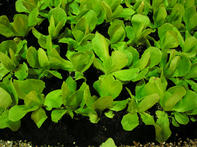Propagation
Propagation of lettuce is by seed. Although lettuce seed can germinate in cool temperatures as low as 5°C, the best germination temperatures to ensure even and fast development of seedlings and to ensure that there are uniform plants to harvest and market are between 18°C and 22°C.
Planting Method
Planting is done by direct seeding of the seedbed and thinning the plants to the desired plant density after emergence, although this is quite labour intensive and therefore expensive.
Most commercial growers will plant greenhouse produced seedlings that will be ready four to five weeks after sowing of the seeds. Planting on smaller lots can be done by hand but most planting is done by mechanical planters or by mechanical assistance planting.
Spacing
Plant density of lettuce varies with the kind of lettuce planted but should be anything from 60 000 to 120 000 plants per hectare.
They are planted on 1000 mm to 1200 mm raised seedbeds consisting of three to five rows 20 to 30 cm apart of plants spaced from 15 to 20 cm apart in the rows. The raised seed beds are normally dictated by the width of the tractor and implements’ wheels.
Sowing Time
Sow the lettuce seeds in early spring or in autumn when the temperatures have started to cool after the heat of summer.Planting Time
Plant seedlings throughout the year as long as the temperatures are correct and where there are not excessive winter frosts that with kill or damage the plants.
Up to 3 crops can be attained in areas where the temperatures are suitable. In greenhouses, lettuce can be planted throughout the year and growing period will normally be between half and two-thirds of the time required by open field production.
Growth Period
The four main types of lettuce have different growth and maturity stages and times. Iceberg lettuce: 10 to 12 weeks from planting to maturity. Butter lettuce: Six to 10 weeks.
Romaine lettuce: 10 to 12 weeks. Loose leaf lettuce: Can be cropped continuously for extended harvest periods from about five to six weeks onwards.
Fertilisation
Always fertilise according to the soil sample analysis that has been taken prior to planting. In the absence of this, a good pre-plant application of 750 kg of 2:3:4 (30) can be incorporated into the top 30 cm of the plant row for the seedlings to get a good head start.
A second fertiliser application of 250 kg of LAN can be side-dressed along the plant rows four to five weeks after planting to boost vegetative growth.
If using drip irrigation, as many commercial farmers now prefer, the equivalent liquid fertiliser can be applied through the water drippers as fertigation.
Irrigation
Irrigation is done by overhead pivot, sprinkler, micro jet or drip irrigation. The most efficient being drip irrigation as just the correct applications are applied and wastage is curtailed.
As lettuces consist of more than 80% of water, they are very sensitive to water and irrigation stress. This can be due to under-irrigating, which will cause loss of production and wilting.
Water stress can also result from waterlogging through over-irrigating, which leads to anaerobic conditions in the root zone and root rot diseases.
It is best to monitor the soil closely and irrigate as the soil tension builds up. Install irrometers or other devices throughout the plant area to monitor soil moisture content daily.
By Louise Brodie